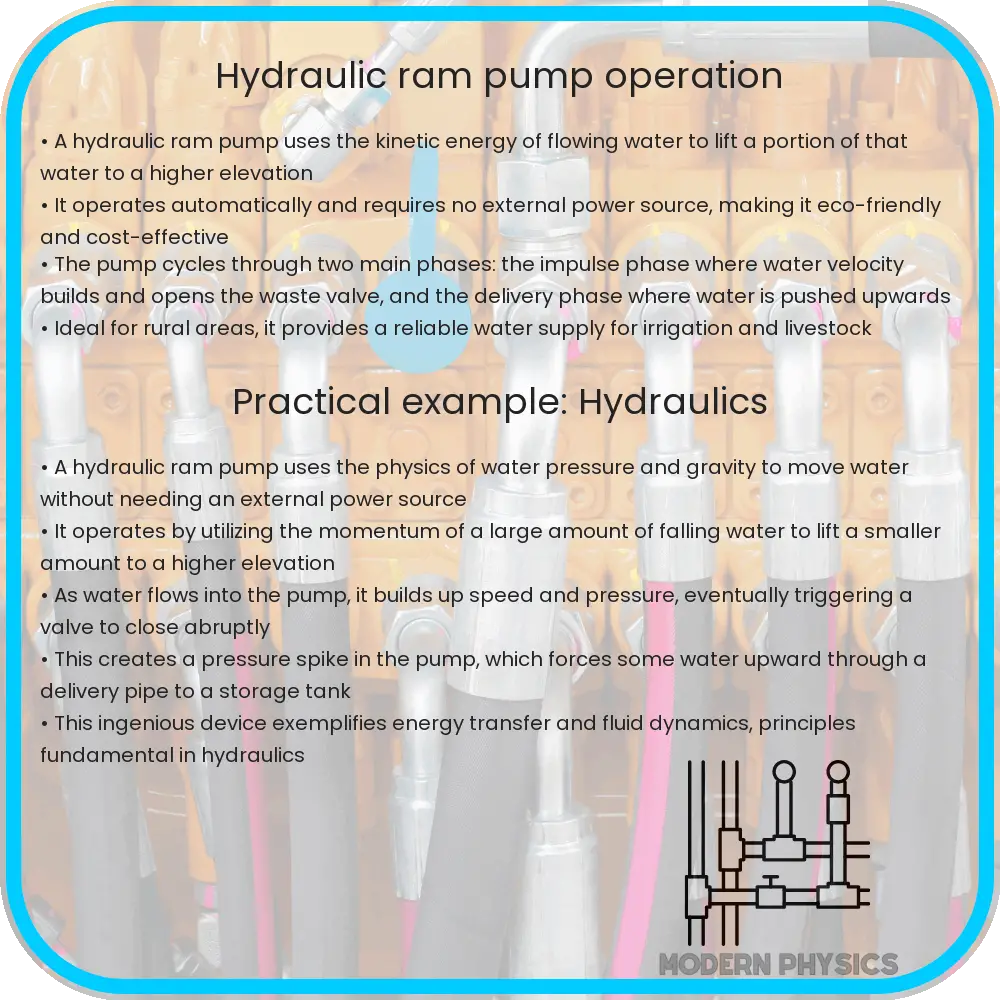Explore the efficient and eco-friendly hydraulic ram pump: its design, operation, and impact in sustainable water lifting technology.

Understanding the Hydraulic Ram Pump
The hydraulic ram pump, a marvel of engineering, operates on the principles of fluid dynamics and is a testament to sustainable technology. Utilized primarily for lifting water to higher elevations without the need for an external power source, this pump harnesses the energy of a large amount of water falling a short distance to lift a small amount of water to a much higher elevation.
Efficiency and Environmental Impact
One of the key advantages of the hydraulic ram pump is its remarkable efficiency and minimal environmental impact. It operates using the water hammer effect, a phenomenon where a sudden change in the flow of water creates an energy wave within the pump. This energy is then used to lift a portion of the water upwards. As it requires no fuel or electricity, its operational costs are significantly low, and it produces no emissions, making it an environmentally friendly solution for water transportation.
Design Considerations
Designing a hydraulic ram pump involves careful consideration of various factors to ensure optimal performance. The two main components of the pump are the waste valve and the delivery valve. The waste valve allows water to flow through the pump and creates the water hammer effect when it suddenly closes. The delivery valve then directs the water upwards. The size and design of these valves are critical to the pump’s efficiency. Additionally, the source of water and the height to which the water needs to be lifted are crucial parameters in the design process.
Fluid Dynamics in the Hydraulic Ram Pump
Understanding the fluid dynamics involved in the operation of a hydraulic ram pump is essential. When the waste valve closes, the momentum of the water flow generates a pressure spike, known as water hammer. This pressure spike opens the delivery valve, allowing a portion of the water to enter the delivery pipe. The inertia of the water in the delivery pipe then closes the delivery valve, preventing the water from flowing back, and thus lifts the water to a higher elevation.
Optimizing Performance through Design
To maximize the efficiency of a hydraulic ram pump, the design must be tailored to the specific conditions of its intended location. The fall of water, known as the ‘drive head’, and the rise to which the water needs to be pumped, referred to as the ‘delivery head’, are crucial in determining the pump’s size and specifications. A higher drive head generally allows for a greater delivery head. Moreover, the diameter of the pipes, both for the drive water and the delivery, significantly affects the flow rate and efficiency of the pump. These parameters must be balanced to achieve optimal performance.
Material Selection and Maintenance
The longevity and durability of a hydraulic ram pump are heavily reliant on the materials used and the maintenance practices employed. Commonly, pumps are constructed from robust materials like cast iron or stainless steel to withstand the constant water flow and pressure changes. Regular maintenance, such as cleaning the valves and checking for leaks in the pipes, is essential to ensure the pump operates efficiently over a long period.
Applications and Impact
Hydraulic ram pumps are particularly beneficial in remote or rural areas where electricity is scarce or unavailable. They are used in agricultural irrigation, livestock watering, and even in small-scale hydroelectric power generation. The technology, while old, continues to provide a sustainable and cost-effective solution for water lifting, significantly impacting communities by improving water access without the burden of ongoing fuel or electricity costs.
Conclusion
In conclusion, the hydraulic ram pump is a remarkable example of harnessing natural forces for practical applications. Its operation, grounded in the principles of fluid dynamics and the efficient use of energy, offers a sustainable solution to water transportation challenges, especially in remote and rural areas. By understanding and optimizing the design, material selection, and maintenance of these pumps, we can significantly enhance their efficiency and longevity. As we continue to seek environmentally friendly and cost-effective technologies, the hydraulic ram pump remains a vital tool, embodying the ingenuity and resilience of sustainable engineering solutions.
